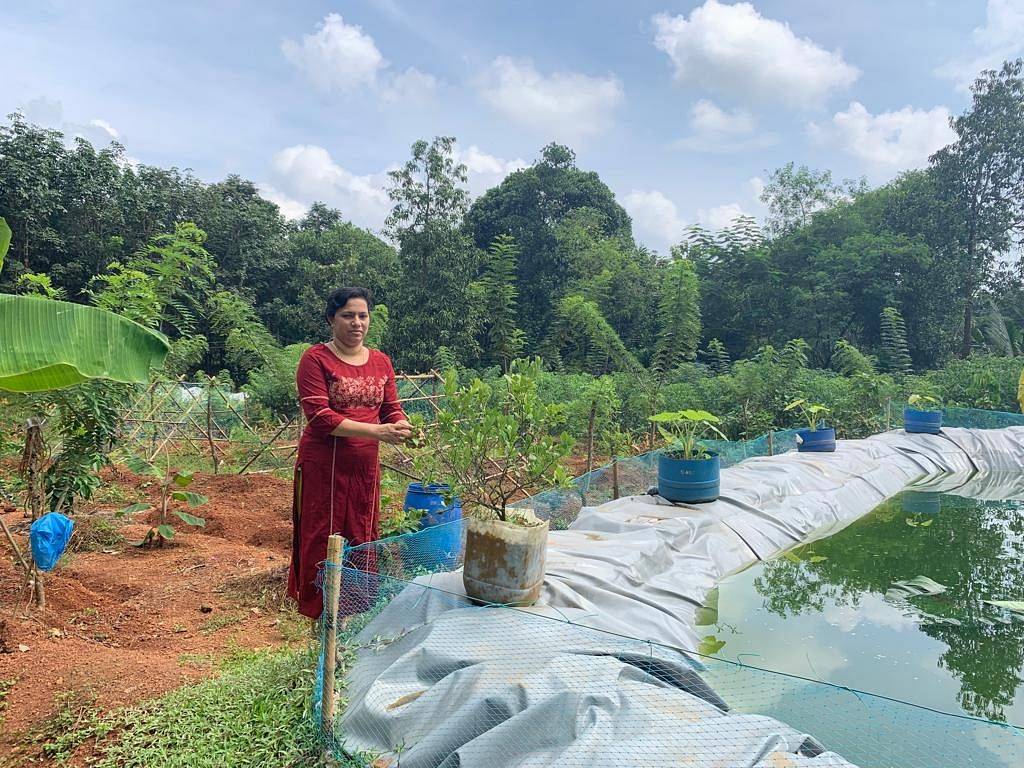
Swapna James is a farmer from Kerala with a 15-acre farm. She has used every inch of the farm wisely and strategically to execute a farming technique known as intercropping. Her passion in farming intensified after she got married.
She chose to assist her husband James in organic farming 15 years ago and received training from the Agriculture Department and Krishi Vigyan Kendra (KVK). In the process, she managed to put Kerala's Palakkad district's small village of Kulakkattukurissi on the organic agricultural map of India.
While she began with a little investment, she has already doubled her income and persuaded other farmers in the region to abandon chemical use in favor of organic farming. Today, she earns an average of Rs.2 lakh per acre, and the farm generates up to Rs.30 lakh per year, which is nearly double what she was making earlier.
Companion planting
Swapna claims that the training she got gave her the courage to explore with her formerly mono cultural land (a one crop land). She planted coconut, arecanut, cocoa, nutmeg, coffee, jackfruit, and pepper instead of only one crop (rubber). Tapioca, banana, ginger, turmeric, yam, bitter gourd, chilly, snake gourd, snake gourd, different tuber crops, and other crops are also grown in her land.
"At first, we were employing chemicals to develop rubber, which resulted in losses. Either demand would decrease or, if our plantation was devastated, we would have no other source of revenue. The soil quality had already deteriorated, and our only advantage was that we had a large amount of property. In 2006, we began to diversify. We knew we could fall back on rubber plantations if it didn't work," Swapna, a mother of two, explains.
She adopted intercropping, which involves growing one crop between rows of other crops. She has also included a fishpond and animal husbandry as additional revenue generators.
"The crops are chosen in such a way that reduces water usage, boost soil fertility, fix nitrogen, and resist pest attacks. The optimal combination is achieved through a series of attempts and errors. It is critical to keep track of how the plants, roots, seeds, fruits, and flowers react during the experiments. The crops share sunlight and nutrients rather than fighting for them," Swapna adds.
Swapna has planted coconut, nutmeg, and turmeric all together. Shade-loving trees such as nutmeg and turmeric can grow in between coconut trees. Rubber is also intercropped with cocoa, coffee, vegetables, and bananas. She sows in accordance with the growth of rubber plants. She grows crops that require more sunlight in early weeks and crops that can be grown in the shade later in the season. Pulses and legumes are planted between the trees to fix nitrogen, and crops like coriander and turmeric are excellent pest repellents, according to her.
Swapna has been able to grow numerous varieties of each plant due to the companion plantation methods. She has cultivated 45 distinct mango varieties, such as chandrakaran, mallika, sindhooram, kalapadi; 33 distinct jackfruit trees, such as gumless, muttam varikka, thenvarikka, sindhoori; 26 nutmeg varieties, 14 different guava trees, eight lemon family trees, 12 okra variants, and more.
She also cultivated milk fruit (star apple), pomegranate, cherry, mulberry, strawberry, custard apple, and passion fruit.
Tulsi (Holy Basil), chittamruth (Giloy), panikoorkka (Patta Ajwain), and kacholam are some medicinal herbs (Galanga). With different harvesting patterns, intercropping guarantees a consistent cash flow throughout the year.
Swapna also saves money on input expenses, which she has significantly reduced by keeping three cows to create jeevamrutham (cow urine + dung) as a natural fertiliser.
She also uses Beejamrutha and Panchagavya. While jeevamrutha may be utilized at any stage of cultivation, panchgavya is most effective before blossoming. The latter is a five-ingredient mixture of cow dung, cow urine, curd, milk, and ghee that improves soil fertility and repels pests. Swapna occasionally adds jaggery and banana to the mixture. Meanwhile, beejamrutha (a combination of lime, water, cow dung, and cow urine) is used to treat soil-borne diseases in seeds.
Every year, she collects dry leaves and repurposes them as mulch for the soil, and she collects nearly 4 lakh litres of rainwater in the artificial pond.
"I rarely buy anything from outside. We do buy neem cakes and seeds from outside for some cycles, but the expenses are extremely low," Swapna says.
She was given the 'Innovative Farmer' award by the Indian Agricultural Research Institute (ICAR) earlier this year for her diverse expertise and successful experiments.











